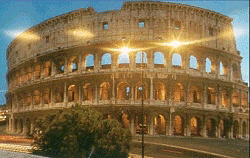|
   




 |

 | Location:
The Colosseum is located in the historic city of Rome, Italy.
|
 | History:
The Colosseum in Rome (70-82) |
|
 |
is best known for its multilevel system of vaults made of
concrete. The open-air Colosseum, completed in AD 80, is one of the grandest monuments of
ancient Rome. It is called the Colosseum for a colossal statue of Nero that once stood
nearby, but its real name is the Flavian Amphitheater. It was used for staged battles
between lions and Christians, among other spectacles, and is one of the most famous pieces
of architecture in the world.
Although the Colosseum has been damaged in several earthquakes, much of it is still
standing. Only a portion of its masonry remains, however.
 | Architecture:
The Colosseum is the popular name for the Flavian Amphitheater in Rome. Situated
between the Esquiline and Palatine hills, near the southeast end of the Forum, it was so
named because the amphitheater stood next to a colossal 37.2-m high (120-ft) statue (now
demolished) of Nero. Construction of the Colosseum was started by Vespasian in AD 69. When
inaugurated (AD 80) by his son Titus, the immense oval superstructure stood 49 m high (160
ft) and covered an area 187 m long (615 ft) by 156 m wide (510 ft).
Marble and wooden seats accommodating up to about 50,000 spectators surrounded an arena 86
m by 54 m (280 ft by 175 ft). The floor of the arena was made of heavy wooden planks;
chambers below housed animals for the games. The ravenous beasts were passed from these
chambers to the arena by means of special corridors and counterbalanced elevators.
Sometimes the flooring was removed and the entire area flooded for mock naval battles.
According to a 4th-century document the Colosseum at Rome seated 87,000 persons; modern
scholars, however, believe that only about 50,000 persons could be seated. |

|
|
|
